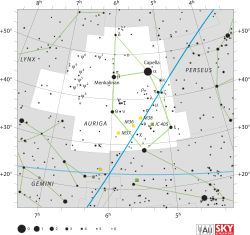Pi Aurigae
| Pi Aurigae (π) | |
 | |
| Observationsdata Epok: J2000.0 | |
|---|---|
| Stjärnbild | Kusken |
| Rektascension | 05t 59m 56,0994s[1] |
| Deklination | +45° 56′ 12,248″[1] |
| Skenbar magnitud () | +4,25[2] |
| Stjärntyp | |
| Spektraltyp | M3 II[3] |
| U–B | +1,83[2] |
| B–V | +1,72[2] |
| Variabeltyp | Långsam irreguljär variabel (LC)[4] |
| Astrometri | |
| Radialhastighet () | 0,71 ± 0,76[5] km/s |
| Egenrörelse (µ) | RA: -2,42[1] mas/år Dek.: -7,32[1] mas/år |
| Parallax () | 3,88 ± 0,85[1] |
| Avstånd | ca 800 lå (ca 260 pc) |
| Absolut magnitud () | -2,46[6] |
| Detaljer | |
| Radie | 265[7] R☉ |
| Luminositet | 6 493[8] L☉ |
| Temperatur | 3 388 ± 6[9] K |
| Metallicitet | 0,03± 0,04[9] dex |
| Andra beteckningar | |
| π Aurigae, 35 Aurigae, BD +45 1217, HD 40239, HIP 28404, HR 2091, SAO 40756. [10] | |
Pi Aurigae (π Aurigae, förkortat Pi Aur, π Aur) som är stjärnans Bayerbeteckning, är en ensam stjärna[11] belägen i den mellersta delen av stjärnbilden Kusken. Den har en genomsnittlig skenbar magnitud på 4,25[2] och är synlig för blotta ögat där ljusföroreningar ej förekommer. Baserat på parallaxmätning inom Hipparcosuppdraget på ca 3,9[1] mas, beräknas den befinna sig på ett avstånd på ca 800 ljusår (ca 260 parsek) från solen. På det beräknade avståndet minskas stjärnans magnitud med 0,54 enheter genom skymning orsakad av interstellär gas och stoft.[5]
Egenskaper
Pi Aurigae är en röd, ljusstark jättestjärna av spektralklass M3 II[3]. Den har en radie som är ca 265[7] gånger större än solens och utsänder från dess expanderade fotosfär ca 6 500[8] gånger mera energi än solen vid en effektiv temperatur på ca 3 400[9] K.
Pi Aurigae klassificeras som en långsam irreguljär variabel av LC-typ och dess ljusstyrka varierar från magnitud +4,24 till +4,34.[4]
Källor
- Den här artikeln är helt eller delvis baserad på material från engelskspråkiga Wikipedia, tidigare version.
Referenser
- ^ [a b c d e f] van Leeuwen, Floor (November 2007), "Validation of the new Hipparcos reduction", Astronomy and Astrophysics, 474 (2): 653–664, arXiv:0708.1752v1 , Bibcode:2007A&A...474..653V, doi:10.1051/0004-6361:20078357. Note: see VizieR catalogue I/311.
- ^ [a b c d] Johnson, H. L.; et al. (1966), "UBVRIJKL photometry of the bright stars", Communications of the Lunar and Planetary Laboratory, 4 (99), Bibcode:1966CoLPL...4...99J.
- ^ [a b] Morgan, W. W.; Keenan, P. C. (1973), "Spectral Classification", Annual Review of Astronomy and Astrophysics, 11: 29, Bibcode:1973ARA&A..11...29M, doi:10.1146/annurev.aa.11.090173.000333.
- ^ [a b] Ruban, E. V.; et al. (September 2006), "Spectrophotometric observations of variable stars", Astronomy Letters, 32 (9): 604–607, Bibcode:2006AstL...32..604R, doi:10.1134/S1063773706090052.
- ^ [a b] Famaey, B.; et al. (January 2005), "Local kinematics of K and M giants from CORAVEL/Hipparcos/Tycho-2 data. Revisiting the concept of superclusters", Astronomy and Astrophysics, 430 (1): 165–186, arXiv:astro-ph/0409579 , Bibcode:2005A&A...430..165F, doi:10.1051/0004-6361:20041272.
- ^ Anderson, E.; Francis, Ch. (2012), "XHIP: An extended hipparcos compilation", Astronomy Letters, 38 (5): 331, arXiv:1108.4971 , Bibcode:2012AstL...38..331A, doi:10.1134/S1063773712050015.
- ^ [a b] Lang, Kenneth R. (2006), Astrophysical formulae, Astronomy and astrophysics library, 1 (3rd ed.), Birkhäuser, ISBN 3-540-29692-1. The radius (R*) is given by::
- ^ [a b] McDonald, I.; et al. (2012), "Fundamental parameters and infrared excesses of Hipparcos stars", Monthly Notices of the Royal Astronomical Society, 427: 343, arXiv:1208.2037 , Bibcode:2012MNRAS.427..343M, doi:10.1111/j.1365-2966.2012.21873.x.
- ^ [a b c] Wu, Yue; et al. (January 2011), "Coudé-feed stellar spectral library - atmospheric parameters", Astronomy and Astrophysics, 525: A71, arXiv:1009.1491 , Bibcode:2011A&A...525A..71W, doi:10.1051/0004-6361/201015014.
- ^ "pi. Aur -- Pulsating variable Star". SIMBAD. Centre de données astronomiques de Strasbourg. Hämtad 2012-08-20.
- ^ Eggleton, P. P.; Tokovinin, A. A. (September 2008), "A catalogue of multiplicity among bright stellar systems", Monthly Notices of the Royal Astronomical Society, 389 (2): 869–879, arXiv:0806.2878 , Bibcode:2008MNRAS.389..869E, doi:10.1111/j.1365-2966.2008.13596.x.
Externa länkar
- https://www.universeguide.com/star/piaurigae
- http://stars.astro.illinois.edu/sow/piaur.html













